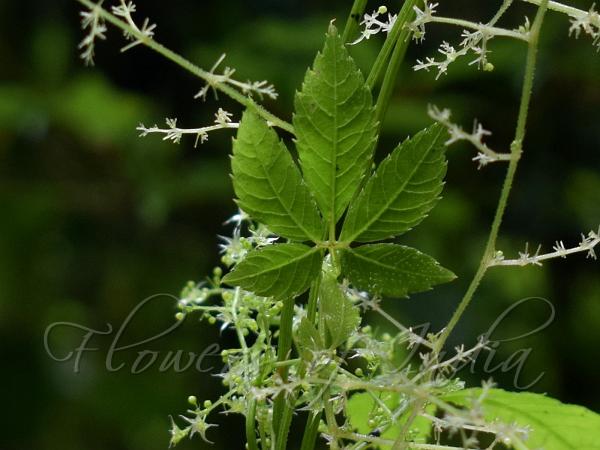|
| Sweet Tea Vine |
|

|

| File size | 352628 |
| Original date | 9/28/19 12:31 PM |
| Resolution | 1600 x 1200 |
| Flash | Flash did not fire |
| Focal length | 40.0mm |
| Exposure time | 1/80s |
| Aperture | 5.0 |
| Focus Distance | |
| Metering Mode | Center weighted average |
| Camera make | NIKON CORPORATION |
| Camera model | NIKON D5300 |
| Sensor type | OneChipColorArea |
|
|
|
|
Photo: |
Botanical name: Gynostemma pentaphyllum Family: Cucurbitaceae (Pumpkin family)
Synonyms: Vitis pentaphylla, Gynostemma wightianum, Gynostemma laxum
Synonyms: Vitis pentaphylla, Gynostemma wightianum, Gynostemma laxum
Sweet Tea Vine is a perennial climbing herb with stem
and branches slender, angular-grooved, hairless or sparsely
velvet-hairy. Leaves are pedately 3-9-foliolate, usually 5-7-foliolate,
membranous or papery, velvet-hairy or hairless. Leaflets are
ovate-oblong or lanceshaped, median leaflets 3-12 x 1.5-4 cm, lateral
leaflets smaller, both surfaces sometimes bristly, lateral veins 6-8
pairs, base narrowed, margin rounded toothed, tip pointed or shortly
tapering; leaflet-stalk 1-5 mm. Tendrils are thread-like, 2-split. Male
flowers are borne in panicle; flower-cluster-stalk thread-like, 10-15
cm, many branched; flower-stalks thread-like, 1-4 mm; bracteole
subulate; sepal-cup tube very short; segments triangular, about 0.7 mm,
tip pointed; flowers pale green or white; segments ovate-lanceshaped,
2.5-3 x about 1 cm, 1-veined, tip long tapering. Female flowers:
panicle shorter than that of male flowers; sepal-cup and flower as in
male flowers; ovary spherical, 2- or 3-loculed; styles 3; stigmas
2-lobed; staminodes 5, short. Sweet Tea Vine is found in the
Himalayas, east to China and Japan, Malaysia, and also Ceylon, at
altitudes of 1500-2600 m.
Flowering: March-November.
Medicinal uses: Jiaogulan is rated among the
ten most important tonic herbs in China. The whole plant is a tonic
herb that improves the circulation, stimulates liver function,
strengthens the immune and nervous systems, and reduces blood sugar and
cholesterol levels. It also has sedative effects, relieving spasms and
lowering the blood pressure. It is used internally in the treatment of
nervous tension and exhaustion, peptic ulcer, asthma, bronchitis,
diabetes, cardiovascular disease and cancer.
Jiaogulan is rated among the
ten most important tonic herbs in China. The whole plant is a tonic
herb that improves the circulation, stimulates liver function,
strengthens the immune and nervous systems, and reduces blood sugar and
cholesterol levels. It also has sedative effects, relieving spasms and
lowering the blood pressure. It is used internally in the treatment of
nervous tension and exhaustion, peptic ulcer, asthma, bronchitis,
diabetes, cardiovascular disease and cancer.
Medicinal uses:
 Jiaogulan is rated among the
ten most important tonic herbs in China. The whole plant is a tonic
herb that improves the circulation, stimulates liver function,
strengthens the immune and nervous systems, and reduces blood sugar and
cholesterol levels. It also has sedative effects, relieving spasms and
lowering the blood pressure. It is used internally in the treatment of
nervous tension and exhaustion, peptic ulcer, asthma, bronchitis,
diabetes, cardiovascular disease and cancer.
Jiaogulan is rated among the
ten most important tonic herbs in China. The whole plant is a tonic
herb that improves the circulation, stimulates liver function,
strengthens the immune and nervous systems, and reduces blood sugar and
cholesterol levels. It also has sedative effects, relieving spasms and
lowering the blood pressure. It is used internally in the treatment of
nervous tension and exhaustion, peptic ulcer, asthma, bronchitis,
diabetes, cardiovascular disease and cancer. | Identification credit: N Arun Kumar | Photographed in Yuksom, West Sikkim. |
• Is this flower misidentified? If yes,